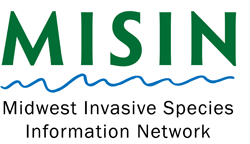|
Russian olive (Elaeagnus angustifolia)
Introduced to North America from Eurasia.
Why is it a problem? Like most invasive plants, Russian olive replaces native plants in high quality natural areas, which in turn reduces critical food resources for birds, butterflies, and other wild creatures. Although it does provide a healthy supply of late season berries, Russain olive does not sustain insect populations during the growing season that songbirds require for their nestlings to survive to adulthood. What does Russian olive look like? Deciduous thorny shrub or small tree growing up to 30 ft. in height. It is rounded in shape with a loose arrangement of branches. Its leaves are simple, alternate, oblong and 1.5-3 inches in length with untoothed margins. They are a light green color, covered in silvery star-shaped hairs above and silvery white scales below. Russian olive flowers in early June-July, shortly after leave emergence. The flowers are small yellow umbel-shaped with silver on the inside, presented either single or clustered. How do I manage Russian olive? Monitor edge habitats during growing season when distinctive foliage is present, early detection is critical as large stands are extremely difficult to eradicate. Hand pulling smaller seedlings can be effective. Use cut-stump herbicide treatment with larger trees. Basal bark treatment may be effective on smaller trees. Burning, mowing, cutting and girdling all stimulate resprouting in larger plants without herbicide treatment. |
|
| habitatmatters.org |
Contact US231-252-4148
3334 Veterans Drive Unit A Traverse City, Michigan 49685 |
Pleasant Peninsula Design, Habitat Matters 2017




